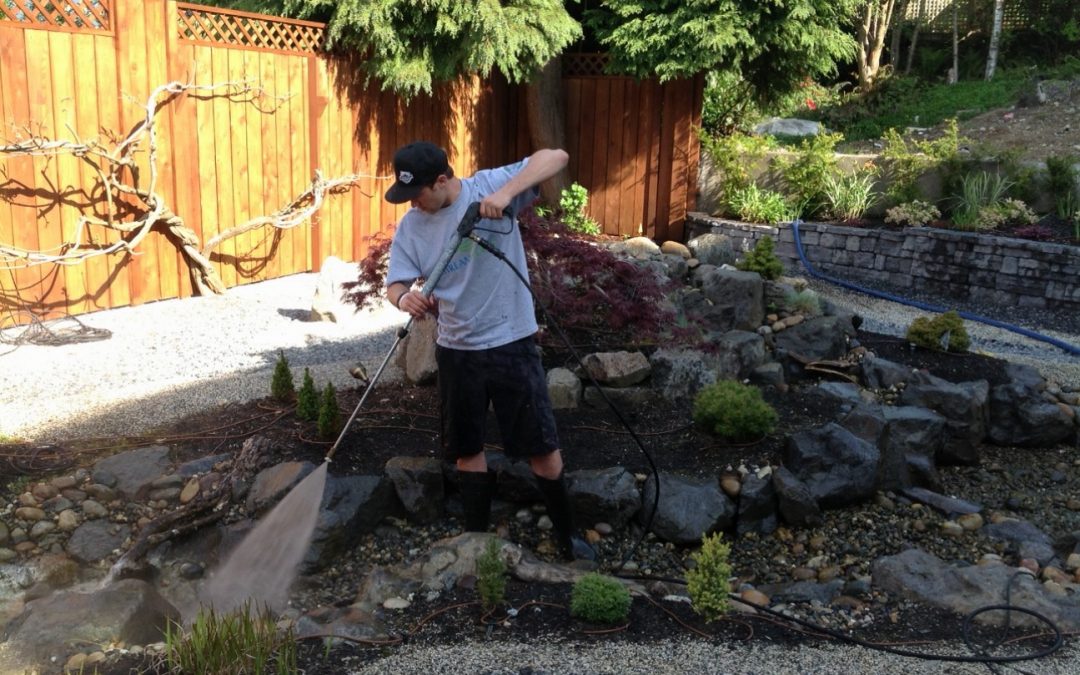Spring is in the air!
Well maybe not quite, but soon! Soon enough that it’s time to start thinking about waking that water feature up from its winter slumber with some spring cleaning. Spring is one of the most exciting times of the year for pond owners, and there are a few things you should do to ensure your water feature starts the season off on the right foot!
First off you will want to assess the situation. Is your pond water quite dark and is there a thick layer of debris on the bottom? If so you will want to think about a full clean out. However, if the water looks decent and there’s minimal debris, you maybe be able to simply stir it up and clean out the debris with a net. The other determining factor will be the water temperature. Ideally you will want to do your clean out BEFORE the water temperature reaches 55F or about 13 degrees Celsius. This will ensure that you are not disturbing the delicate bacteria colonies that create your ecosystem once your feature kicks into gear.
If you’re doing a full clean out on an average sized pond (11’x16’), budget for 4-8 hours to do everything properly. If you have a pondless waterfall, a clean out will take much less time. Here are a few items that will make life easier during the clean out:
- Cleanout pump with 20+’ of hose
- Garden Hose with Nozzle
- Pruners (scissors may do the trick)
- A couple of buckets for leaves and debris
- A large vessel (children’s pool or similar) to contain fish if you have them
- A fish net
- Pond Detoxifier
- Cold Water Bacteria
Place the cleanout pump at the deepest part of the feature and pump the dirty pond water into your landscape. It’s filled with nutrients so don’t be shy to water your shrubs with it! If you have fish, pump some of the water into the large vessel for storage later. Once the water level is down to 1/3 capacity it will be much easier to catch your fish with the net. Gently transfer them to the vessel filled with pond water and cover in a shady area so they don’t jump out. Make sure not to leave them there for more than a few hours – if you have to leave them for longer make sure to aerate the water.
Now you can take your hose (or pressure washer if you have one) and spend 10-15 minutes rinsing down the inside of the pond. Working your way from top to bottom, try to blast heavy debris from the rocks and stir up what may be left on the bottom. You can periodically turn on the clean out pump to drain the dirty water. Please note that you DON’T have to get every little bit of algae – in fact leaving some behind will be beneficial later on as it will help re-establish your ecosystem.
As far as any filters go, you can manually remove any debris from the skimmers or snorkel vaults and clean any media nets or filter pads that may be present in the biofalls. You can now gently rinse these out in pond water. Again – leaving a little algae on your filter pads etc is a good thing. You don’t need to boil them!
You’re now ready to fill your pond back up but make sure to include Pond Detoxifier to take the chlorine and chloramines out of city water. This is very important for the safety of your fish. Also important is acclimatizing the fish to their new water. Scoop up your fish into a bucket of the old pond water in their holding tank; float the bucket in the pond for about 15 minutes and then splash a little bit of the new pond water into the bucket. By now the temperatures should’ve equalized and you can pour them into their new home!
PRO Tip: While your water feature is drained for spring cleaning, it’s a great time to prune and fertilize any deep water plants (like lilies, for example). It’s also a great time to reposition lights or change bulbs if need be and if you don’t have lights at all….. Well, get them in there now!
Contact Streamworks Designs for all of your water feature maintenance needs.

Recent Comments